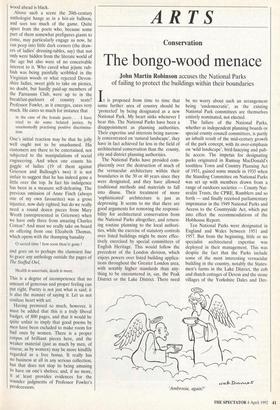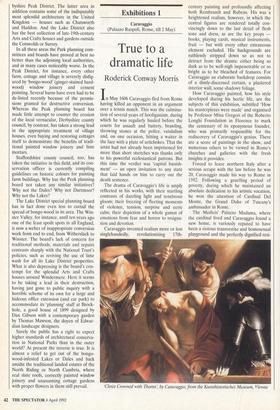ARTS
Conservation
The bongo-wood menace
It is proposed from time to time that some further area of country should be 'protected' by being designated as a new National Park. My heart sinks whenever 1 hear this. The National Parks have been a disappointment as planning authorities. Their expertise and interests being narrow- ly concentrated on 'natural landscape', they have in fact achieved far less in the field of architectural conservation than the county, city and district planning authorities.
The National Parks have presided com- placently over the destruction of much of the vernacular architecture within their boundaries in the 30 or 40 years since they were designated, and they have allowed traditional methods and materials to fall into disuse. Their treatment of more 'sophisticated' architecture is just as depressing. It seems to me that there are good arguments for removing the responsi- bility for architectural conservation from the National Parks altogether, and return- ing routine planning to the local authori- ties, while the exercise of statutory controls over listed buildings might be more effec- tively exercised by special committees of English Heritage. This would follow the precedent of the London division, which enjoys powers over listed building applica- tions throughout the Greater London area, with notably higher standards than any- thing to be encountered in, say, the Peak District or the Lake District. There need be no worry about such an arrangement being 'undemocratic', as the existing NatiOnal Park committees are themselves entirely nominated, not elected.
The failure of the National Parks, whether as independent planning boards or special county council committees, is partly an inbuilt result of the mid-century growth of the park concept, with its over-emphasis on 'wild landscape', bird-fancying and pub- lic access. The impetus for designating parks originated in Ramsay MacDonald's toothless Town and Country Planning Act of 1931, gained some muscle in 1935 when the Standing Committee on National Parks was set up with members drawn from a range of outdoors societies — County Nat- uralist Trusts, the CPRE, Ramblers and so forth — and finally received parliamentary imprimatur in the 1949 National Parks and Access to the Countryside Act, which put into effect the recommendations of the Hobhouse Report.
Ten National Parks were designated in England and Wales between 1951 and 1957. But from the beginning, little or no specialist architectural expertise was deployed in their management. This was despite the fact that the Parks include some of the most interesting vernacular building in the country, notably the States- men's farms in the Lake District, the cob and thatch cottages of Devon and the stone villages of the Yorkshire Dales and Der- 'Ambrosia, again?' byshire Peak District. The latter area in addition contains some of the indisputably most splendid architecture in the United Kingdom — houses such as Chatsworth and Haddon. And the Lake District also has the best collection of late-19th-century Arts and Crafts houses and gardens outside the Cotswolds or Surrey.
In all these areas the Park planning com- mittees and boards have proved at best no better than the adjoining local authorities, and in many cases noticeably worse. In the Peak District, for instance, every other farm, cottage and village is severely disfig- ured by 'bongo-wood' (ginger-stained hard- wood) window joinery and cement pointing. Several barns have even had to be de-listed recently because of the permis- sions granted for destructive conversion.
Whereas the Peak planning board has made little attempt to counter the erosion of the local vernacular, Derbyshire county council, by contrast, has taken a strong lead in the appropriate treatment of village houses, even buying and restoring cottages itself to demonstrate the benefits of tradi- tional painted window joinery and lime mortars.
Staffordshire county council, too, has taken the initiative in this field, and its con- servation officer is currently compiling guidelines on historic colours for painting farm buildings. Why has the Peak planning board not taken any similar initiatives? Why not the Dales? Why not Dartmoor? Why not the Lakes?
The Lake District special planning board has in fact done even less to curtail the spread of bongo-wood in its area. The Win- ster Valley, for instance, until ten years ago one of the least spoilt spots in all England, is now a welter of inappropriate conversion work from end to end, from Witherslack to Winster. The board's lack of concern for traditional methods, materials and repairs contrasts sharply with the National Trust's policies, such as reviving the use of lime wash for all its Lake District properties.
What is also depressing is the board's con- tempt for the splendid Arts and Crafts houses around Windermere. Here it seems to be taking a lead in their destruction, having just gone to public inquiry with a horrible scheme of its own for a large and hideous office extension (and car park) to accommodate its 'planning' staff at Brock- hole, a good house of 1899 designed by Dan Gibson with a contemporary garden by Thomas Mawson, the doyen of Edwar- dian landscape designers.
Surely the public has a right to expect higher standards of architectural conserva- tion in National Parks than in the outer world? At present the reverse is true. It is almost a relief to get out of the bongo- wood-infested Lakes or Dales and back amidst the traditional landed estates of the North Riding or North Cumbria, where real slate roofs, correctly painted window joinery and unassuming cottage gardens with proper flowers in them still prevail.



























































 Previous page
Previous page